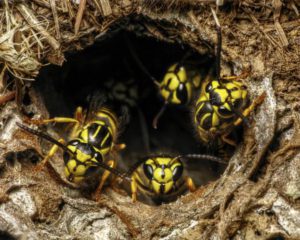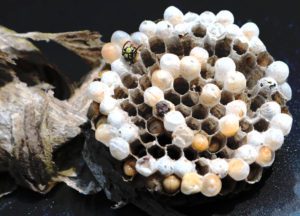HOW DO YOU KNOW IF YELLOWJACKETS ARE NESTING IN YOUR HOUSE?
By Chris Williams on August 13, 2019.

Yellowjackets in a ground nest. Shutterstock.
It’s pretty scary to think that you could have yellowjackets nesting inside your house and not realize it. That scenario seems to be happening with increasing frequency. In our area, there are at least two common yellowjacket species (German yellowjacket and common yellowjacket) that frequently choose to nest hidden in building wall voids, or ceilings, or attics, instead of in the ground or in trees like normal yellowjackets should (see Field Notes About Yellowjackets).
You won’t see an indoor yellowjacket nest out in the open, except perhaps in an unoccupied attic. An indoor yellowjacket nest in a void could grow to be even bigger than a basketball but it won’t have such a nice round shape. The nest is usually constructed to fit between wall joists and around pipes or other utility lines. If you opened the wall void to an active nest, you would probably see several tiered nest combs that contain wasp larvae and pupae surrounded, at least partially, by a papery covering (see Dealing With a Wasp’s Nest Inside a Wall).
HOW ARE YELLOWJACKETS GETTING INSIDE?
Yellowjackets might have a nest, even a nest of good size, in your walls without you even realizing it. Even when the nest is inside a structure, yellowjackets still must come and go from the outside. If their entrance opening to the nest is on an area of your house that is rarely seen or hard to reach, they could be active for a long time without anyone noticing. The wasps might be entering the void through a hole in mortar, space around a window frame, or an opening around a conduit, vent, or exhaust fan. Entrance points can be hard to see and your first indication of a nest might be the humming or buzzing sound, rather than the sight, of yellowjacket activity. (Reason #1 to leave this to the professionals!)
Unfortunately, finding the opening that the yellowjackets are using to get inside doesn’t mean that you have found the location of the nest. It may be just inside the opening or it may be as much as 30 feet from the entrance. If you try to inject wasp spray or other insecticide into the opening, chances are that you won’t even reach the nest and you will make a lot of wasps very angry. (Reason #2 to leave this to the professionals!)
DO NOT ATTEMPT A DO-IT-YOURSELF PROJECT
It’s difficult and risky enough trying to treat a wasps’ nest that is outside and in the open; don’t even try to eliminate an indoor nest. Admit that you don’t know what you’re doing in this case. There’s a very good chance that you will make the situation worse.
Never close off the outside entrance hole leading to the nest in a misguided attempt to keep the yellowjackets out because desperate yellowjackets will then try to find or create find a new opening out of their void space. Trapped yellowjackets are likely to chew right though drywall and end up in a living space. A bunch of angry yellowjackets dropping through the ceiling into your child’s bedroom is something you don’t want to witness! (Reason #3 to leave this to the professionals!)
Homeowners don’t consider the fact that any insecticide spray or dust that they blow under pressure into the nest entrance opening or into the void space is going to travel through that space and out through any other openings such as wall outlets, light fixtures, light switches, vents, etc., ending up in living spaces. (Reason #4 to leave this to the professionals!)
A pro knows where to look for yellowjacket entrance points. A pro may have a listening device and thermal imaging tools that can help pinpoint the location of the nest inside the wall or ceiling void. A pro knows what insecticide products to use where. A pro knows to check for and seal off any openings into other rooms before treatment and to monitor during and after treatment. And a Colonial Pest pro comes with a guarantee that the job will be done right.
THERE ARE POST-TREATMENT CONCERNS, TOO
Finally, even after the nest has been located and treated and the wasps are dead, you must decide what you are going to do next. Do you open up the wall or ceiling and remove the nest? Do you leave the nest as is? There are arguments either way. It depends on the location of the nest, the size of the nest, and the cost of removal and repair.

Remnants of a small yellowjacket nest. Z. Ciras
Generally, you don’t want to leave a nest with lots of dead wasps and wasp larvae because you can end up with odor problems as well as infestations of flies or scavenger beetles that feed on dead insects and even the nest material (see Should a Wall Void Yellowjacket Nest Be Removed?). A pest control technician can discuss the pros and cons with you. (Reason #5 to leave this to the professionals!)
If you know or have reason to believe that yellowjackets are occupying a nest site within your walls, don’t delay in contacting a professional. Yellowjacket nests grow in size and numbers throughout the summer; the sooner the nest is eliminated, the better. Call Colonial Pest!